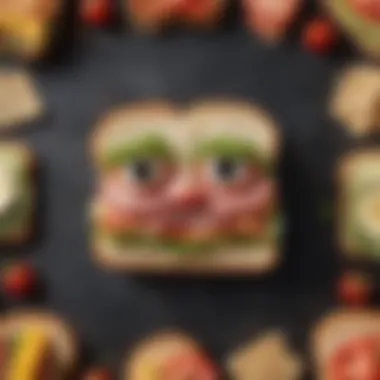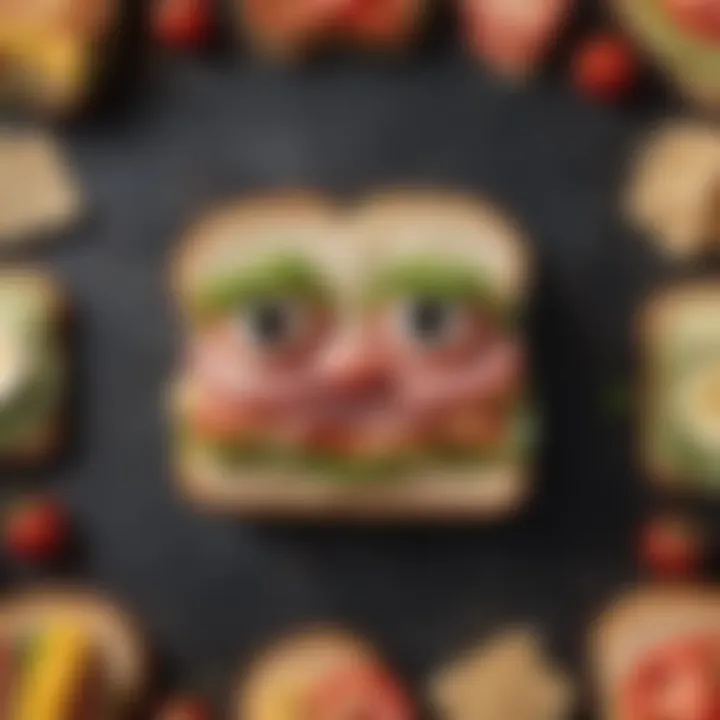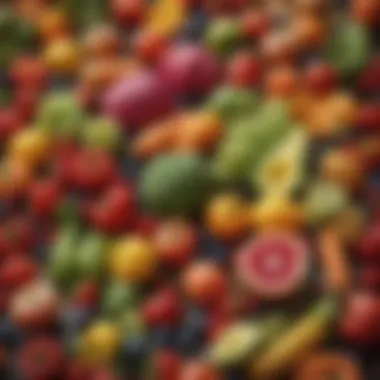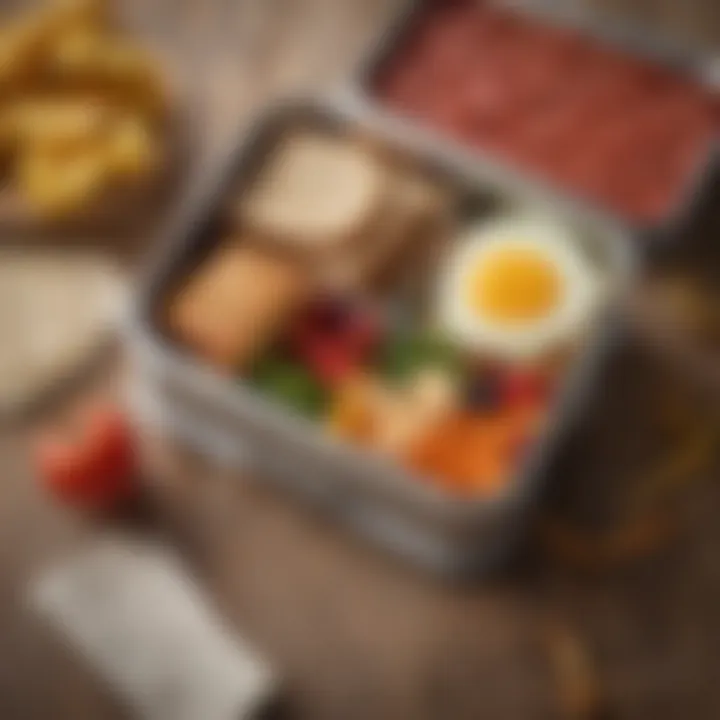Healthy and Easy Lunch Ideas for Preschoolers


Intro
Creating nutritious lunches for preschoolers can be both a challenge and a rewarding experience. As children grow, their dietary needs change, and providing meals that cater to their developing bodies is crucial. A good lunch for preschoolers not only has to satisfy their taste buds but also ensure a balanced intake of essential nutrients.
In this article, we will explore various lunch ideas tailored for preschool-aged children. Emphasis will be placed on nutritional balance, ease of preparation, and the appeal of the meals to young palates. We will highlight the importance of including diverse food groups. By understanding their dietary needs, parents can simplify the process of preparing wholesome lunches for their kids.
The following sections will examine specific components of an ideal preschool lunch, including recipes, nutritional information, and practical cooking tips. Through this detailed guide, parents can make informed decisions while offering meals that support their children's growth and health.
Understanding Nutritional Requirements for Preschoolers
Understanding the nutritional requirements for preschoolers is critical for parents aiming to provide appropriate lunches. Preschoolers experience rapid growth and development, making proper nutrition essential. A well-balanced diet supports their cognitive development, physical growth, and overall health. Knowing what nutrients are necessary and how to combine them effectively will help parents prepare appealing meals that meet these young children's needs.
Essential Nutrients for Growth and Development
Proteins
Proteins are vital for building and repairing tissues. For preschoolers, proteins play a critical role in muscle development and immune function. High-quality protein sources include lean meats, fish, eggs, dairy, legumes, and nuts. Including proteins in lunch helps children stay full longer and contributes to their overall growth. Preschoolers need about 5-7 grams of protein per meal, depending on their activity levels. A balance is needed, as excessive intake can lead to digestive issues. Therefore, incorporating a variety of protein sources in lunch is encouraged.
Carbohydrates
Carbohydrates are an important energy source for preschoolers. They fuel brain function and support physical activity. Whole grains, fruits, and vegetables provide the necessary carbohydrates more effectively than refined options like white bread or sugary snacks. It is important to select carbohydrates with a low glycemic index, as they release energy steadily. This prevents energy crashes often seen after consuming simple sugars. The recommended intake of carbohydrates for lunch should include about 30-40 grams, depending on the activity level of the child.
Fats
Fats are essential for many bodily functions, including brain development. Healthy fats from sources like avocados, nuts, seeds, and olive oil should be included in preschoolers' lunches. Fats help with the absorption of fat-soluble vitamins such as A, D, E, and K. However, it is crucial to limit saturated and trans fats which can lead to health issues like obesity and heart disease in the long term. A guiding rule is to ensure fats constitute about 25-35% of total daily calorie intake.
Vitamins and Minerals
Vitamins and minerals support various bodily functions, from bone health to immune system efficiency. Key vitamins such as A, C, and D, along with minerals like calcium and iron, should be part of preschoolers' diets. These nutrients can be found in fruits, vegetables, dairy, whole grains, and lean meats. Each vitamin and mineral plays a unique role. For example, calcium strengthens bones, while Vitamin C improves iron absorption. It is important to provide varied food sources to meet the recommended daily allowances, as deficiency can affect growth and health.
Portion Sizes Appropriate for Preschoolers
General Guidelines
Knowing the appropriate portion sizes for preschoolers is key to avoiding overfeeding or underfeeding. General guidelines suggest that portion sizes for kids should be about one-quarter of an adult’s serving size. This accounts for their smaller stomachs and unique nutritional requirements. A balanced plate should include a variety of foods in appropriate amounts to ensure they receive all essential nutrients without excessive calorie intake. Parents can use the palm of the child’s hand as a rough guide for serving sizes.
Adjusting Portions Based on Activity
Portion sizes should also be adjusted based on the child’s daily activity levels. More active preschoolers might need larger portions than less active peers. Additionally, when special activities are planned, such as physical education classes or playtime, parents may wish to enhance food portions pre-activity. Keeping an eye on the child's hunger cues will help tailor lunch to their specific needs each day.
Considerations for a Balanced Lunch
When crafting a lunch for preschoolers, one must keep in mind the fundamental concept of balance. A balanced lunch encompasses various food groups, which ensure that children receive adequate nutrition for their growth and development. This not only contributes to their physical health but also supports cognitive functions and energy levels throughout the day.
Each food group has unique benefits. Thus, considering how to incorporate them into meals is crucial. It's also essential to be aware of common dietary avoids, to not only nourish but protect young bodies from harmful ingredients. Parents should think of these aspects carefully when preparing meals.
Incorporating Food Groups
Fruits
Fruits serve as excellent sources of vitamins and minerals, essential for a child's well-being. They are typically rich in fiber, which aids digestion and prevents constipation. The key characteristic of fruits is their natural sweetness, which makes them a popular choice among preschoolers.
Fruits can be served in various imaginative forms. For example, cut into fun shapes or presented as dippers with yogurt. This unique feature can make fruits more appealing, encouraging children to enjoy them. The only downside might be that some fruits require preparation, adding a small task for busy parents.
Vegetables
Vegetables are vital for maintaining a well-rounded diet, offering numerous health benefits. They are low in calories but high in essential nutrients like vitamins A and C. A key characteristic of vegetables is their variety, as they come in many colors and flavors.
This diversity allows for creativity when preparing meals. Unique features include their ability to be hidden in sauces or mixed into dishes. While it may be challenging to get picky eaters to accept them, being persistent often leads to positive outcomes.
Whole Grains
Whole grains are an important aspect because they provide energy and vital nutrients. They contain more fiber than refined grains, promoting satiety. A key characteristic of whole grains is their nutty flavor and chewiness, which appeals to many children.
Including whole grains, such as oats or brown rice, creates a nutritious base for a meal. However, some preschoolers may resist the change from white rice or regular bread, which can be a hurdle to overcome initially.
Dairy


Dairy products, including milk, yogurt, and cheese, are fundamental in providing calcium and protein needed for bones and muscle development. The creamy texture and taste of dairy products are appealing to many young taste buds. A unique feature of dairy is its versatility; it can be consumed as a drink or included in meals.
Noting lactose intolerance in some children is important, as it may limit dairy options. Parents can look for alternatives like almond milk or lactose-free products to ensure their children still receive essential nutrients.
Avoiding Common Dietary Pitfalls
Excessive Sugar
Excessive sugar in preschoolers' diets mainly arises from processed foods and drinks. High sugar consumption can lead to health issues like tooth decay and obesity. Recognizing and limiting sugary snacks ensures that children focus on nutrient-rich foods, promoting better health.
The key characteristic of excessive sugar is its presence in unlikely foods, such as yogurt or bread. The unique feature of sugar is its addictive nature, often making children crave more sweet foods, which can complicate meal planning.
High Sodium Content
High sodium content is often linked to processed and packaged foods. Sodium can contribute to health problems, including elevated blood pressure, even in young children. Being vigilant about reading labels helps parents avoid high-sodium options, focusing instead on fresh, whole ingredients.
A key point in this context is that many preschoolers are unaware of taste differences and can adjust to lower sodium options over time.
Processed Foods
Processed foods often contain unhealthy fats, excessive salt, and sugar, which can undermine a balanced diet. Limiting these products encourages healthier eating habits and promotes the intake of whole, nutritious meals. The unique feature of processed foods is convenience, but they often lack nutritional value.
Parents should strive for a balanced approach, gradually replacing processed items with fresh alternatives to enhance their child’s meals while developing their taste for healthy foods.
Understanding the balance of nutrients and food choices is key to creating a healthy lunch for preschoolers.
Types of Lunches That Appeal to Preschoolers
When preparing lunches for preschoolers, it is essential to focus on what makes meals appealing to them. Engaging lunches not only enhance the eating experience but also promote healthy eating habits. Children are often attracted to colorful and creatively presented foods. Such approaches encourage them to explore a variety of flavors and textures while providing necessary nutrients.
Fun and Engaging Presentation Ideas
Colorful Plates
Colorful plates make meals visually appealing. Brightly colored fruits and vegetables can capture a child’s interest. For example, a plate filled with red strawberries, orange carrots, and green cucumber slices creates an inviting display.
Key characteristics: They engage a child’s curiosity, spark interest, and invite them to try new foods. Colorful plates can also reflect different food groups, showcasing the diversity of their meal.
Unique feature: This presentation encourages preschoolers to eat a variety of foods. It has the advantage of encouraging visual appeal, making the lunch experience more enjoyable. However, if not planned well, it can lead to mismatched flavors that might overwhelm young palates.
Creative Shapes
Food shaped into animals, stars, or other fun forms can excite preschoolers. Using cookie cutters, parents can create sandwiches, fruits, and vegetables in playful shapes. This encourages kids to engage with their food in a different way.
Key characteristics: Creative shapes promote a more playful atmosphere around eating, making the experience enjoyable.
Unique feature: Kids may be more likely to eat foods that are presented in shapes they find amusing. One disadvantage is that this could require extra time to prepare and does not always align with busy schedules.
Interactive Elements
Incorporating interactive elements into lunches encourages kids to participate in their meal. For instance, allowing them to assemble wraps or dips with a variety of sides promotes engagement and choice.
Key characteristics: Engaging children in their food preparations helps them feel involved. This can lead to increased willingness to try different foods.
Unique feature: It not only makes mealtime engaging but also teaches children about food combinations. However, it may require supervision and can create more mess, which could be a drawback in some settings.
Popular Lunch Combinations
Wraps and Sandwiches
Wraps and sandwiches provide a good balance of nutrition. They can include proteins, vegetables, and spreads all in one compact meal. Using whole grain bread or wraps enhances the fiber content of the meal.
Key characteristics: They are versatile and can be adjusted to suit a child’s preferences.
Unique feature: Parents can experiment with different fillings, ensuring variety. However, some children may be picky about the texture or flavor of certain ingredients, which can limit options.
Bento Boxes
Bento boxes are an excellent way to maximize variety in a preschool lunch. These allow parents to include small portions of multiple foods. This presentation can make meals visually appealing while also promoting balance.


Key characteristics: Bento boxes encourage balanced meals incorporating different food groups.
Unique feature: They can include an assortment of tastes, from savory to sweet. A potential downside is their preparation can take extra time, especially if parents aim to create visually appealing arrangements.
Dips and Sides
Including dips like hummus or yogurt with crackers, veggies, or fruits is a great way to enhance lunch appeal. Dips can provide a fun way for children to engage with their food.
Key characteristics: Dips encourage preschoolers to try different food combinations with flavors they enjoy.
Unique feature: They promote interactive eating, as kids can mix and match what they are dipping. One disadvantage is that some dips may not be a favorite for every child, limiting options for engagement.
Meal Prep Strategies for Busy Parents
Preparing lunches for preschoolers can be challenging for busy parents. This section explores meal prep strategies that optimize time and ensure that children receive nutritious and appealing meals. The key elements in this approach include organizing cooking routines and making the best use of available time while still adhering to dietary needs. These strategies aim to lessen daily stress and create a sustainable lunch routine.
Batch Cooking and Storage Solutions
Freezing Meals
Freezing meals is a practical method for busy parents looking to save time and ensure nutritious options for their preschoolers. By preparing meals in advance and storing them in the freezer, families can easily access healthy choices without the need for elaborate daily cooking. One significant aspect of freezing meals is that parents can maintain portion control, making it easier to serve appropriate quantities for young children.
The unique feature of freezing meals is that it allows for a variety of options to be prepared ahead of time. This flexibility often leads to better food choices, as parents can include a range of ingredients without feeling pressured to cook on a tight schedule. However, there can be a disadvantage if items are not labeled properly, leading to confusion over what is available. Keeping track of what goes into the freezer can help alleviate this issue and enhance meal planning.
Storing Leftovers
Storing leftovers is another effective strategy that contributes significantly to meal preparation for preschoolers. It allows families to maximize the use of food and minimize waste. When meals are prepared in larger quantities, leftovers can be saved and used later, making mealtime quicker and easier.
The key characteristic of storing leftovers is their convenience. By utilizing surplus food from dinner, parents can create quick lunches with little extra effort. This approach can free up time for other activities and can maintain a balanced diet by ensuring that meals contain similar nutrients. A possible drawback is the threat of monotony, where children may not be excited to eat the same meals multiple times. Introducing variety in the flavors and components of the leftovers can help in overcoming this concern.
Organizing the Kitchen
Organizing the kitchen is crucial for effective meal prep. A well-structured kitchen space can make it easier for parents to prepare meals quickly and efficiently. This involves designating specific areas for different types of food and prepping tools, which ultimately saves time when assembling lunch.
One key benefit of organizing the kitchen is that it allows families to easily find ingredients, which in turn encourages healthier eating habits. When healthy ingredients are readily accessible, it becomes easier to create balanced lunches. On the downside, maintaining organization requires ongoing effort; chaotic kitchen environments can lead to confusion and hinder meal planning. Consistent organization efforts can make this a beneficial choice for busy parents preparing lunches for preschoolers.
Quick Assembly Lunches
Ingredients to Keep on Hand
Having a well-curated selection of ingredients on hand is essential for quick assembly lunches. Certain staples can expedite the lunch-making process, ensuring that healthy and fun meals are always within reach. These ingredients should include a variety of proteins, vegetables, fruits, and grains.
The key characteristic of having go-to ingredients is that they provide flexibility and speed when preparing meals. This ensures that parents can whip up nutritious lunches without feeling overwhelmed. However, there’s a risk of relying too heavily on certain ingredients, which can lead to limited meal variety. To combat this, it's advisable to regularly rotate and introduce new items to keep the meals exciting for preschoolers.
Simple Recipes that Assemble Easily
Incorporating simple recipes that can be assembled easily is integral for busy parents. These recipes require minimal preparation and can often be put together in minutes. By focusing on straightforward components, parents can maintain quality while ensuring their children receive balanced lunches.
One of the key characteristics of these recipes is their inherent simplicity. They often rely on a few ingredients, which can help reduce meal-making time dramatically. The downside is that some of these recipes may lack the culinary flair that can elevate a meal beyond the basics. To counter this, it’s important to embrace creativity even within simple frameworks, allowing for enjoyable eating experiences for preschoolers.
Regularly reviewing meal strategies can provide better insights for enhancing lunchtime experiences while accommodating dietary needs.
Addressing Dietary Restrictions and Preferences
When it comes to planning lunches for preschoolers, understanding dietary restrictions and preferences is key. This consideration not only ensures the child’s health and well-being but also fosters a positive eating experience. Children may have allergies to certain foods or simply develop preferences based on taste or texture. Catering to these needs is important for their nutritional intake and overall comfort during mealtime.
Options for Picky Eaters
Identifying Preferences
Identifying preferences in preschoolers forms a foundation for creating meals they will enjoy and eat. Each child is unique in their tastes, which can change frequently. Parents and caregivers can take a proactive approach by observing what foods their children gravitate towards. This might include certain colors, flavors, or types of cuisine. One key characteristic of this approach is the ability to engage the child in the process. It allows them to feel involved and excited about their meals, making the experience more enjoyable.
Advantages of identifying preferences include avoiding meal refusals, which can lead to waste and frustration. It also fosters a healthier relationship with food. However, it has disadvantages too, such as the potential for narrowing the child’s diet if overemphasized on certain foods, making it harder to introduce new choices later.
Sneaking in Healthy Options
Sneaking in healthy options is a creative way to maintain nutrition while catering to a child’s tastes. This involves integrating nutritious ingredients into meals without drawing attention to them. A key characteristic here is the ability to disguise healthy foods in appealing formats, like blending spinach into a fruit smoothie or incorporating grated carrots into mac and cheese. This can be a beneficial strategy in this article because it supports parents in circumventing resistance to vegetables and other healthy components.
The unique feature of sneaking in healthy options is its flexibility. Parents can adjust recipes based on their child’s preferences and nutritional needs. However, caution is needed. If children discover they are being tricked, this can lead to distrust regarding food and meal choices in the future.


Inclusive Lunch Ideas
Vegetarian Choices
Vegetarian choices serve an important role in offering diverse, nutritious lunches for preschoolers. Numerous studies indicate that children on vegetarian diets can meet their nutritional needs effectively. By including plant-based proteins like lentils, beans, and tofu, parents provide meals rich in fiber, vitamins, and minerals. This variety is a significant characteristic of vegetarian lunches, which contributes to a broader palate and acceptance of different foods.
The unique aspect of vegetarian options is that they allow for creativity and experimentation. However, disadvantages may include ensuring adequate protein intake and addressing potential allergies to certain plant foods. Parents must be mindful while planning to ensure a well-rounded diet.
Gluten-Free Alternatives
Gluten-free alternatives are crucial for children with gluten sensitivities or Celiac disease. Offering these choices ensures that no child is left out at lunchtime, fostering an inclusive environment. Gluten-free meals can be derived from whole grains like quinoa and rice, which are naturally devoid of gluten. A key characteristic of gluten-free options is the emphasis on whole, unprocessed foods, which can provide necessary nutrients without the harmful effects of gluten.
The unique advantage of gluten-free alternatives is the growing variety available in stores today. Many products, such as gluten-free pastas and snacks, are designed to cater to this dietary need. Disadvantages include the potential for higher costs and the necessity of careful ingredient checking. It’s important for parents to stay informed about what constitutes a safe gluten-free choice to support their child’s health adequately.
"Addressing dietary restrictions is not about limitation, but about exploration and inclusion in meals that foster growth and joy."
Keeping It Simple and Practical
Keeping lunch preparation simple and practical is crucial for busy parents. Navigating the daily demands of work and family can be overwhelming, especially with young children. By simplifying meal prep, parents can ensure that their preschoolers receive nutritious meals without spending excessive time in the kitchen. This approach not only saves time but also reduces stress for parents.
Time-Efficient Recipes
Five-Minute Meals
Five-minute meals are a practical solution for parents who need to whip up a quick dish. The fast preparation time allows for flexibility during busy mornings or between other responsibilities. These meals often consist of simple, ready-to-eat components. Parents can choose items like yogurt with fruit or pre-packed sandwiches. The fast turnover makes them a beneficial option, as preschoolers will also benefit from having meals prepared without much complexity. The unique feature of these meals is that parents can combine various items from their pantry or fridge quickly. One disadvantage could be the limited variety if the same items are used repeatedly.
Slow Cooker Options
Slow cooker options present another time-saving method in meal preparation. By using a slow cooker, parents can prepare a meal early in the day and let it cook while they focus on other tasks. Stews or vegetable dishes can be made with minimal effort. The key characteristic is the ability to set it and forget it, which allows parents to attend to their preschoolers while the meal cooks. This method is beneficial for its ability to develop flavors slowly. However, one disadvantage is that planning is needed since the meal requires several hours to cook.
Make-Ahead Ideas
Make-ahead ideas are essential for those days when unexpected situations arise. This involves preparing components of meals in advance. For instance, chopping vegetables or cooking grains can make assembling lunch faster. The key characteristic here is organization, as having items prepared ahead of time reduces the stress of last-minute cooking. A unique feature of make-ahead ideas is that they allow for greater variety in meals since different ingredients can be utilized throughout the week. A possible disadvantage could be the risk that prepared ingredients do not always remain fresh if not stored correctly.
Utilizing Leftovers
Transforming Dinner Leftovers into Lunch
Transforming dinner leftovers into lunch is an excellent way to minimize waste and save time. This approach allows parents to provide nutritious meals with little extra effort. The key characteristic is the direct use of meals already prepared. This method is beneficial because it maximizes the effort put into dinner preparation. A unique feature is the potential for creativity, as leftovers can be reimagined into new dishes, like turning roast chicken into wraps. However, there might be limited acceptance from picky eaters if the dish appears too familiar.
Incorporating Ingredients Efficiently
Incorporating ingredients efficiently focuses on using multiple items across different meals. By planning meals that share key ingredients, parents can streamline shopping and cooking time. The key characteristic of this method is its efficiency in both buying and utilizing food. It helps parents keep their grocery bills in check while promoting healthy choices. A unique advantage is the ability to create a diverse menu with fewer items. However, one potential downside could be risk of monotony if the same ingredients are overused.
Evaluating What Works
When considering the lunches for preschoolers, it becomes crucial to evaluate what truly works for each child. This aspect focuses on understanding their preferences, nutritional needs, and how these elements can be balanced effectively. Each child is different, and what may appeal to one may not work for another. Therefore, finding that equilibrium through evaluation is essential. It allows parents to adapt meals and maintain interest in lunch. This section highlights how trial and error can lead to better choices and builds a positive eating experience for preschoolers.
Trial and Error Approach
Encouraging Feedback from Preschoolers
Encouraging feedback is vital since it allows children to express their likes and dislikes about their meals. This feedback shapes future lunches to be more appealing, thus contributing to a positive eating environment. Kids are likely to be more engaged if they feel heard. One key characteristic of this method is its inherent adaptability. Parents can make informed choices based on direct feedback. Gathering this information is beneficial as it guides meal planning toward what children actually enjoy. Personalized lunch choices can lead to increased consumption of nutritious foods.
However, there are challenges here. Younger preschoolers may not articulate their thoughts well, which might lead to misunderstandings. Care must be taken in interpreting signals, as young ones may express dislike even for healthy choices simply because they are new.
Adjusting Based on Preferences
Adjusting based on preferences focuses on modifying lunch options according to the responses from preschoolers. It enhances meal acceptance and creates a sense of ownership among children about their food choices. One significant feature is flexibility. This flexibility means parents can experiment with different ingredients and preparations based on what their child prefers. If a child likes carrots but not peas, meals can be tailored accordingly. This makes it a beneficial choice for promoting healthier eating habits.
On the other hand, a downside includes the risk of becoming too reactive. If adjustments happen too often, children may become finicky or demanding about meals. It is essential to strike a balance that encourages exploration while maintaining some consistent offerings.
Establishing a Routine
Maintaining Consistency
Maintaining consistency creates a sense of security and predictability for preschoolers during meal times. This rhythm reinforces what a typical lunch might look like, helping children understand and anticipate their meals. One of the key characteristics is routine's calming effect; it reduces anxiety around uncertain food choices. For this reason, it is a beneficial aspect of maintaining a stable eating environment. Consistently offering familiar foods can encourage a child to try new items in a low-pressure setting.
However, there is a risk of monotony. If the routine becomes too predictable, children may lose interest in their meals. Thus, incorporating slight variations within a consistent framework can help maintain engagement.
Introducing Variety Gradually
Introducing variety gradually allows for a systematic approach to expanding children's palates. This measure helps children to adapt over time, reducing resistance to trying new foods. One key characteristic of this method is its gentle approach; by presenting new foods alongside familiar ones, the transition can feel less overwhelming. This strategy is beneficial in helping preschoolers to develop a broader taste profile and encourages curiosity about different flavors.
Yet, this approach requires patience and careful observation. Some children may need more time than others to embrace new foods. If pushed too quickly, it could lead to rejection of the new items altogether. It is vital to monitor reactions and adjust timelines based on individual readiness.







